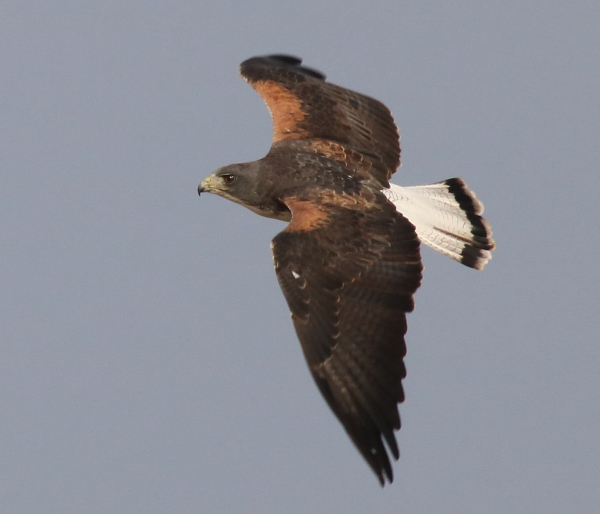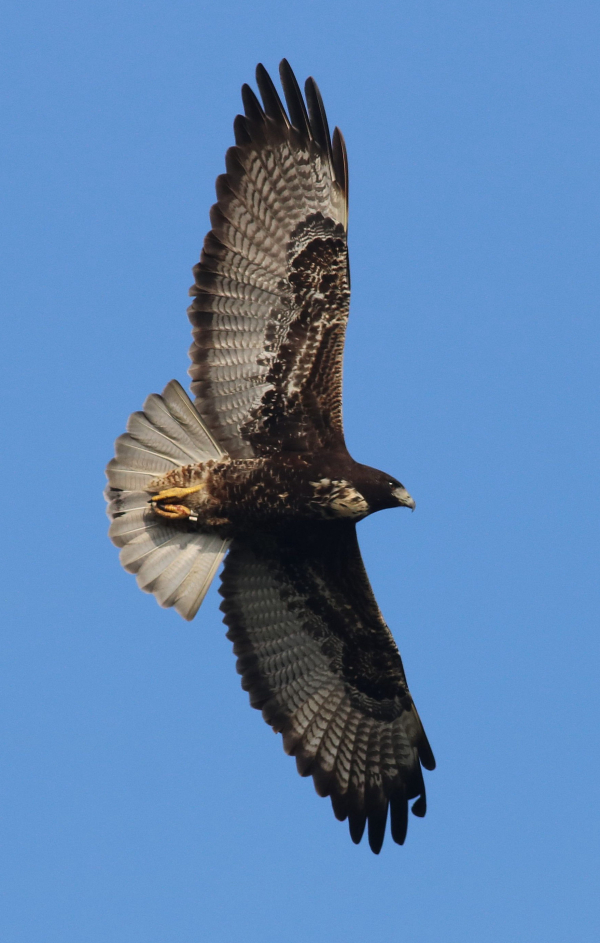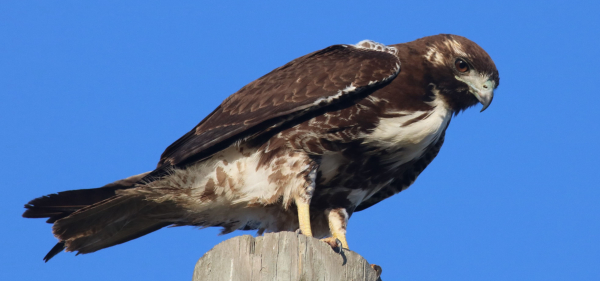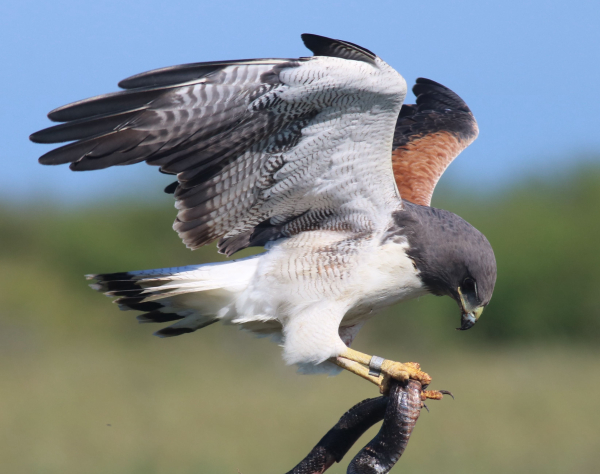Adjacent to two of our finest national wildlife refuges in south Texas – Santa Ana and Laguna Atascosa – I found a variety of birds of prey along the refuge boundaries and adjoining perimeters of agricultural fields that provided many photo opportunities that I greatly appreciated. Previous birding trips to the region didn’t provide raptor access like this visit did, so I took full advantage of the chance to photograph Harris’s Hawks, Crested Caracaras, White-tailed Kites, and wintering Merlins and Red-tailed Hawks. But there was one species I really was emphasizing as photo subjects – White-tailed Hawks – and I actually had the best luck with this species overall.

The banded white tail is obvious on this dorsal view of this adult White-tailed Hawk. Taking photos of these raptors over an extended number of days under a variety of conditions provided an opportunity to document White-tails showing the different plumage types of immature and adult hawks
|
Other refuge visitors were focused on the refuges proper, and while I made the most of birding and photo opportunities within refuge borders, I spent almost as much time along the edges of the refuges. Along the east side of Santa Ana Refuge, there were a couple recently harvested ag fields that attracted a number of birds of prey, including White-tailed Hawks. I used the farm roads to access perched raptors, and to get closer to soaring hawks, as well as trails that ran along the top of elevated dikes built to hold back the Rio Grande during a flood emergency.
Although I was the only apparent refuge visitor to use these trails, and farm vehicles were extremely rare, I was not alone on these driveways; there was also a very active Border Patrol presence. I could just imagine my van ambling slowly and parking so close to the Mexican border to be a point of interest for the agents. I’m sure the van resembled a potential pick-up vehicle for people crossing the border illegally, but the Border Patrol was very considerate and never questioned me as I waved politely when I passed them or they passed me at times. Perhaps my North Dakota license plates were an indication my innocence, if not my camera lens sticking out the driver’s side window periodically.
That aside, the raptors were actively hunting from perches, during soaring flights, hovering flights, and during aerial forays that took them to the ground or the next perch. Some hawks were noticeably resting too, with two Harris’s Hawks providing a memorable view perched on adjacent branches.
One especially interesting thing about my primary birds of focus – White-tailed Hawks – was their variety of plumages, which reflected the age of individual birds, ranging from adult plumage to first-year and immature plumages – rare in North American hawks. Other hawks have first-year plumages, but none has a second immature plumage that I’m aware of – making the White-tails unique. White-tailed Hawks range south from Texas through Mexico and Central America in regional populations, with their most expansive range in South America, where they are found north and south of the Amazon River basin and east of the Andes Mountains.
Documenting Plumages with Gusto

A dramatic banking photo of an adult reveals its white underside and a broad black band at the end of its white tail feathers. White-tailed Hawks have characteristically long wings.
|
To make the White-tail photo collection complete, I needed to get photos of adults from the top or side, and the bottom – they look quite different in dorsal and ventral views. Yet, while I was interested in getting photos of White-tailed Hawks in adult plumage as well as photos of birds that were representative of immature age groups, that seemed like a pipe dream before finding the groups of White-tails adjacent to each of the south Texas refuges. Although I didn’t check off each plumage as I documented it, after I headed back north to Dakota, I realized I not only managed a few good photos of typical adults, but also good examples of the younger birds – almost unbelievable considering I didn’t have one good photo of any White-tail plumage from earlier south Texas visits.
Laguna Atascosa Snake-eater
Laguna Atascosa Refuge also provided a number of photo opportunities for White-tailed Hawks, and one adult in particular provided repeated photo ops and the most dramatic photos of the trip during my last day in South Texas. I usually encountered this adult along the road leading to the refuge (and from it). I photographed this adult perched, in flight, and flying during intense wind; but my favorite photos were when it permitted me to photograph it as it fed on a large Indigo Snake it caught, and tried to keep its balance, flapping its wings at times on and above its fencepost perch as it pulled intently to glean bites of the 5 foot long snake. Action photos like this that add a lot to a collection of species photos.
An interesting side note to that particular bird is that you can see the band on one leg, and when I sent the photo along with a couple others to my friend William Clark, a raptor biologist of worldwide renown who lives in nearby Harlingen, he enlarged the photo so he could read the number – or at least part of it. From the visible numbers on the band, Bill was able to determine that this was a bird he previously captured, banded, and released; and he provided a little history of its movements over the ensuing period, which included a short foray into northern Mexico and its return north of the border. Ah, the importance of documentary photos to birders and biologists alike!
Raptor Photo Tips

In contrast with the above hawk, the underside of an immature White-tailed Hawk might suggest a different species to an untrained eye. Note the gray tail and its white breast patch.
|
As for suggestions about how to take quality photos of White-tailed Hawks – or any raptors or other large birds – it’s first necessary to find these birds. They are not always common in south Texas but, as always, I cover a lot of landscape in my searches for birds to photograph. When I found the two hotspots adjacent to the refuges, I concentrated considerable time during a number of days to get both documentary and photographically interesting photos of this dynamc species.
As you know, I like to use my vehicle as a comfortable mobile blind. I pull safely off the side of the road in the best possible position to photograph a bird with respect to the direction of the sunlight. I always try to keep the sun at my back so the sunlight illuminates the hawk as directly as possible, preferably during morning and afternoon hours.
When photographing from a vehicle I always turn off the engine to keep my camera lens as stable as possible, plus I stabilize my lens on top of the slightly raised window glass or the side of the window frame to reduce any body-shake that may be transferred as I hold my camera in place. I also instinctively hold my breath when I press the shutter button to remain as stable as possible during that critical moment.
It’s usually best to stay inside your vehicle when possible, because raptors and some other birds tend to flush if they see a person moving; however, they tend to be more trusting of a vehicle’s slow approach. But if you need to walk to a certain vantage point, walk slowly and try not to approach the raptor directly. Instead, walk slowly at an angle that gets you progressively closer; stop and bend over as though you are interested in something else; look in other directions and avoid looking at the bird as you approach your favored photo position.

Then too, you should take a photo every few steps as you approach the bird, in case it reacts to you or another stimuli and moves away. When standing, try to stabilize your camera lens on a tree trunk, post, or other object; or form a “chest-pod” by holding your elbows tucked against your chest, forming something of a body tripod to help stabilize your camera as you use it – and hold your breath as you take each photo. Of course, you can use a tripod if you prefer, but that takes all the fun out of photographing birds for me, especially flying birds; and photographing a flying bird using a tripod attached to your camera is never fast or easy. If you disagree, that’s OK too; do what works best for you through your photo experiences and preferences.
I always set the Mode Dial on my camera to the Av preference. Then I set my aperture (f-stop) and the Av mode automatically provides the associated shutter speed with relation to the amount of available light. With ample sunlight, I preset the ISO to 400, and the aperture to f8. The resulting shutter speed will usually be between 1/1200 and 1/2000 of a second – fast enough to stop most motion of a bird in flight. I preset my camera; then when I’m in position to photograph, I double-check the settings and adjust any if necessary.
It’s also a good idea to keep your camera set so you can take a continuous series of photos. When birds are especially active, or when they are flying or soaring, I often hold the shutter release button down for a couple seconds to allow the camera to take a continuous series of images at a rate of 3 to 10 photos per second, depending on the camera model you have. It’s always good to try to anticipate a bird’s movements or flight path, but that’s easier to suggest than it is to do when you’re in the moment. Also, try not to tighten up as you’re photographing; stay loose, follow the action smoothly, and enjoy the experience before, during, and after the photo action.

In the meantime, good luck finding interesting birds to photograph as this fall season progresses! With fall colors abounding, and unseasonal bouts of light snow in the forecast, use changes in the landscape to take photos that may reflect late summer, fall, and even winter settings. It’s an exciting time of the year to photograph birds with flocks of birds providing a lot of incentive to enjoy October and November photo opportunities.
Article and photographs by Paul Konrad
Share your bird photos and birding experiences at editorstbw2@gmail.com